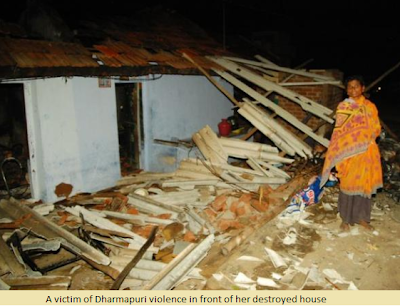Reason for the attack
An inter caste marriage between a Dalit boy and a Vanniyar girl was
the immediate reason for the violent caste conflict. Ilavarasan and Divya were in love for two
years and got married a month before the conflict despite threats from the
local caste Hindus.This impelled the Vanniyar community to call a
Panchayat meeting on 3rd November which portended some extreme
reactions from the upper caste Hindus. Some people gave an ultimatum to the
Dalits that they should return the girl to her house within two days failing to
which they would have to face dire consequences. Dalits fearing some ugly
occurrences requested police protection, which was granted by posting some 20
policemen at the village on 5th November.
On 7th November, Divya’s father Nagaraj commited
suicide when he was told that his daughter decided to stay with llavarasan. Some
people seized this situation to mobilize the Vanniyar community using the dead
body of Nagaraj. Nearly two thousand people carrying the body of the girl’s
father blocked the Dhamapuri-Timpattur road. Simultaneously another group set
ablaze the houses in the three Dalit colonies. All 268 houses were looted and
then set on fire and the rampage continued for almost two hours. Valuable
assets such as television sets, motorbikes, cycles, refrigerators, almirahs,
all were damaged and burnt. All of the residents of the colony were reduced to destitution
as all their savings were either looted or burnt.
Deeper look into the issue
A detailed analysis of the incident exposed a more brutal
picture of the rampage. Everyone who is conversant with the facts about the
incident, including police, are convinced that the incident was pre-planned.
The Panchayat meeting of 3rd November, wherein an ultimatum was issued by some
Vanniyar people, was just a precursor. The suicide of Nagaraj gave an
impression that the rampage was a result of spontaneous reaction, but it was
not. The mobilization of thousands of Vanniyar men within
a few minutes, the police forewarning Dalits in the three colonies, keeping of
police at bay by felling trees, the pattern of attack in which the inmates of
colonies were not harmed physically but their properties destroyed and looted,
all pointed to the fact that the attack was pre-planned. Moreover, the
attacking mobs did not have people from the neighbouring hamlet. People from
villages 20 to 30 km away from the area had already come well prepared in
advance to take part in the attack with 150 litres of petrol and 200 litres of
kerosene in mini trucks to torch the houses. Many of the Dalit victims were
quoted saying that they could not recognize people in the mob, which meant that
the people from distant villages participated in the attack. Even the time of the year for the attack
was well chosen – months when only women , children and the elderly remained in
the colonies as the men went to nearby towns and cities for jobs.
The dalits at Dharmapuri
were basically workers in the
agricultural fields of the Vanniyar community. But later on even though
women still continued to work in fields, men started going outside the village
to fend for their family. They started working in Bangalore and Coimbatore either
as self-employed with such jobs like scrap dealing or in construction
industries. This brought in huge developments in their standards of living.
They became economically more secure as a result of which they began to acquire
more land. They no longer had to depend or show respect to Vanniyars and began
to pursue even higher education. Dalits even started to wield power and to rule
the upper castes as some of the constituencies became reserved. All these
caused resentments in the Vanniyar community.
As aforementioned, the suicide of Nagaraj was not the actual
cause of attack. The economic prosperity of Dalits was both the cause and the
target of attack. Many specifically
targeted families had been able to acquire some land over the years through
their toil. Care was taken not to harm anyone while ensuring that all
properties and means of livelihood were either destroyed or looted. As the
marauding mob entered the villages, the women, children and the elderly ran for
their lives to the nearby hamlets. The mob stole away the money, jewellery and
all other valuables before torching the houses. The vehicles were burnt. The
mob also looted a local Dalit temple and 4.5 kilograms of gold were taken away.
Many Dalits also lost their important documents like educational documents ,
land documents etc.
Another reason
for the mobilization of mob was the caste based policies of PMK chairman
Ramdoss and the public announcements of Kaduvetti Jayankondam Guru, the
PMK MLA. About two months before the incident, he announced that inter-caste
marriages of Vanniyar girls would not be accepted and the men who lure away
Vanniyar girls should be dealt with death penalty. This is deemed to be another
cause for the attack on colonies as the case of Ilavarasan and Divya was not the first
inter-caste marriage in the locality.
The Dharmapuri incident proves that despite the efforts
from government, the violence and discrimination against Dalits continue to
occur. The silence of police force during the attack and forewarning of Dalits
points to the fact that the police require an immediate revival at local level.
The incident also calls for more strict legislations to prevent atrocities
against Dalits and to annihilate caste system and the strict enforcement of the
same.
Links


Jobs in dharmapuri
ReplyDeletevanniyar matrimony leading tamilnadu best leading matrimony website vanniyar matrimony in tamilnadu,vanniyar matrimony in kadalur,vanniyar matrimony in pondicherry,vanniyar matrimony in chennai,vanniyar matrimony villupuram,vanniyar matrimony in vellore,vanniyar matrimony in india,vanniyar matrimony in singapore,vanniyar matrimonial brides,vanniyar matrimonial grooms,free registration vanniyar matrimony,vanniyar find partner,vanniyar manamalai kudalure,chennai,pondicherry,tamilnadu,india.Vanniyar Manamalai.com
ReplyDeleteYou will find dissertation online sites via internet settle purchase not surprisingly well-known while in the web pages. Gods of Dharmapuri Web Series Review
ReplyDelete